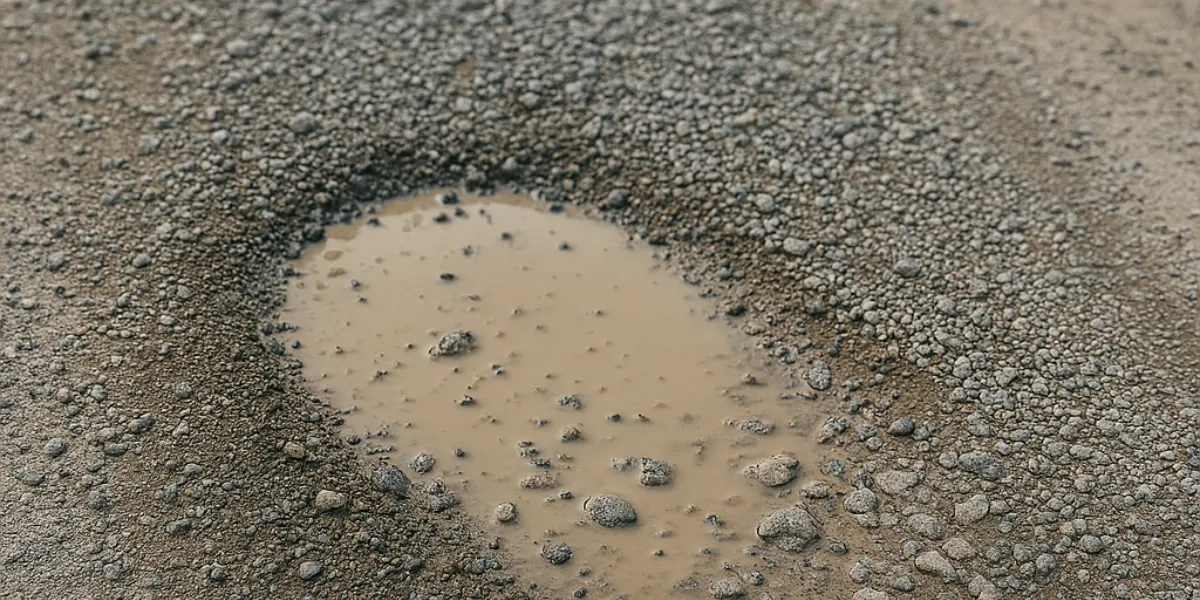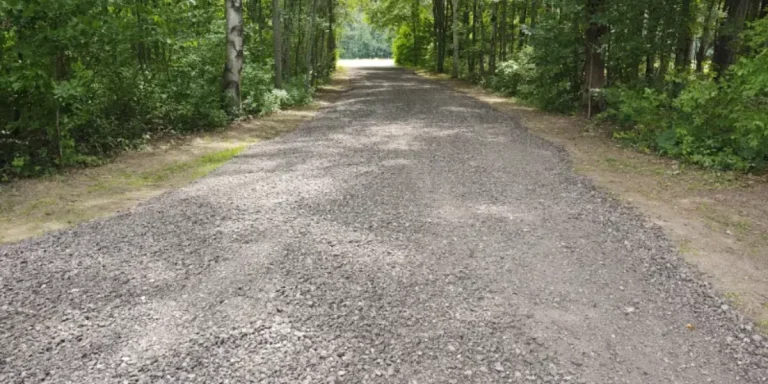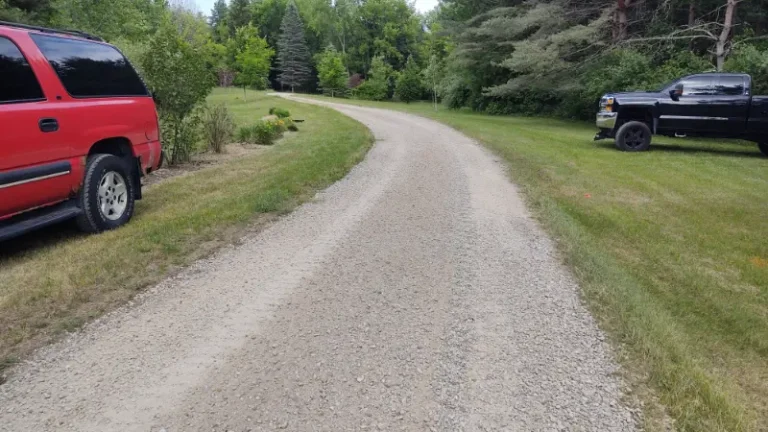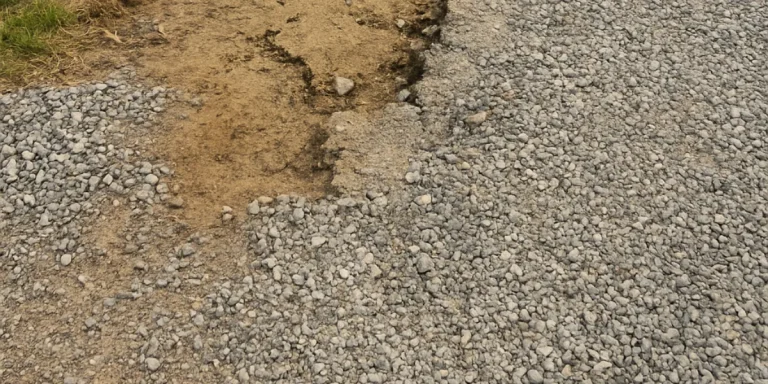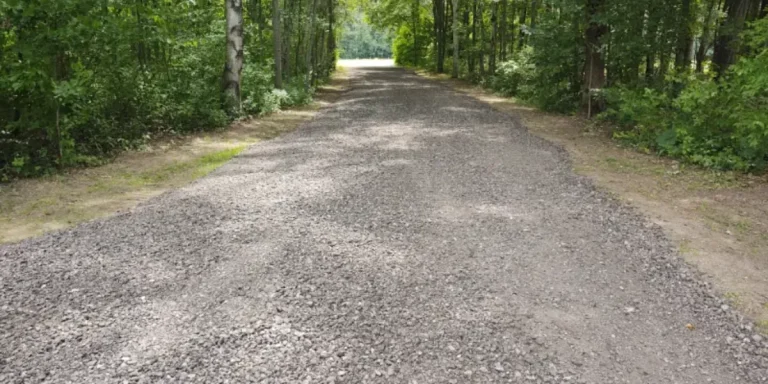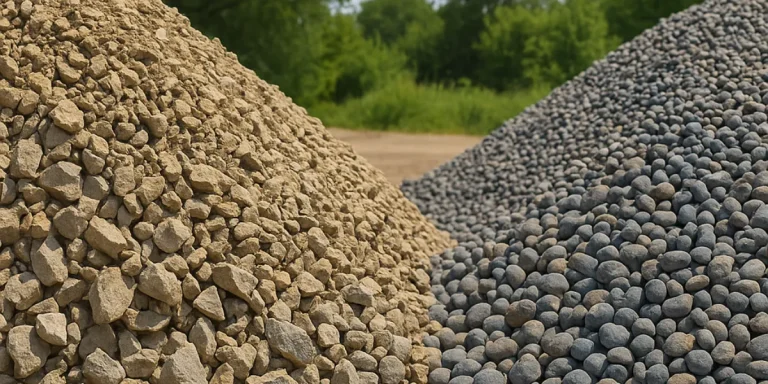What Causes Potholes in Your Gravel Driveway?
If your gravel driveway is starting to feel more like an off-road trail than a smooth surface, you’re not alone. Potholes are a common issue for gravel driveways—especially in areas like Clio, Michigan, where freeze-thaw cycles, heavy rainfall, and regular vehicle traffic all take a toll. Understanding what causes these potholes and how to prevent them can save you from constant repairs and expensive damage.
At Gath’s Landscaping, we specialize in gravel driveway resurfacing and material delivery for homeowners and property managers across Mid-Michigan. In this post, we’ll explain what causes potholes in gravel driveways, how to fix them properly, and why it’s worth investing in a long-term solution.
What is a pothole in a gravel driveway?
A pothole is a small to medium-sized depression in your driveway that forms when the underlying base weakens and the surface gravel is displaced. Unlike simple ruts or surface wear, potholes grow deeper and wider over time, making your driveway uncomfortable to drive on—and potentially damaging to your vehicle.
Common causes of gravel driveway potholes
Potholes in gravel driveways aren’t just random surface damage—they’re the result of specific underlying issues that weaken the structure over time. At Gath’s Landscaping, we’ve worked on hundreds of driveways across Clio, Birch Run, Frankenmuth, and other Mid-Michigan towns, and these are the most frequent causes we see:
1. Poor drainage and standing water
Water is the single biggest threat to a gravel driveway. Without proper drainage, rainwater and melting snow can seep into the gravel and base layers, softening the foundation and eventually washing materials away. This erosion creates voids beneath the surface that collapse under the weight of traffic, forming potholes.
Common signs and contributing factors include:
-
-
- Flat or low-lying areas where water tends to pool
- Improper grading that channels runoff down the center instead of off the sides
- Missing or clogged ditches and swales that can no longer divert water effectively
-
When drainage issues are ignored, potholes will continue to form no matter how often you refill them. That’s why our team often recommends pairing gravel driveway resurfacing with grading or drainage improvements to solve the problem at its root.
2. Inadequate compaction during installation
A strong, long-lasting gravel driveway starts with a solid base. If the driveway wasn’t properly built with layered materials and compacted using the right equipment, it won’t hold up over time.
Some signs of poor compaction include:
-
-
- Thin or loosely packed base layers that allow movement beneath the surface
- Uneven settling, especially in areas with soft soil or previous excavation
- Premature wear in wheel paths, where repeated pressure exposes the weakness
-
Unfortunately, DIY or improperly installed gravel driveways are common throughout Genesee County, and we’re often called in to fix them. Our team at Gath’s Landscaping uses commercial-grade compactors and proper stone gradation to ensure long-term stability during every driveway installation or repair.
3. Heavy vehicle traffic or turning wheels
Even the best-built gravel driveways will wear over time if they see frequent or uneven traffic. This is especially true for:
-
-
- Driveways used by delivery trucks, trailers, or equipment
- Turn-around areas where tires pivot frequently and dig into the surface
- Narrow drives where all traffic follows the same tire path
-
The constant pressure loosens gravel, shifts the base, and eventually creates low spots that collect water—starting the pothole cycle. We help many property owners resolve this by regrading, adding crushed stone with better compaction, and sometimes expanding the driveway to reduce traffic stress on one section.
4. Freeze-thaw cycles
In Michigan’s climate, freeze-thaw cycles are a major factor in pothole formation. Here's how the process works:
-
-
- Moisture seeps into the gravel and soil layers beneath the surface
- Temperatures drop, and the water freezes and expands, lifting the gravel above it
- As temperatures rise, the ice thaws and contracts, leaving empty space or soft ground
- Traffic passes over the weakened area, causing it to collapse into a pothole
-
This cycle repeats throughout late fall, winter, and spring—especially in shaded or poorly drained areas where melting is uneven. Proper base materials, good drainage, and routine resurfacing are your best defense against freeze-thaw damage.
If you're seeing potholes pop up year after year, it may be time to address more than just the surface. At Gath’s Landscaping, we offer full-service solutions—including gravel driveway resurfacing, grading, material delivery, and drainage correction—to stop potholes at the source and give you a driveway that lasts.
How to fix potholes in your gravel driveway
A quick shovel full of gravel might make a pothole disappear for a few days, but it won’t solve the root problem. Without addressing the underlying issues like poor drainage, an unstable base, or compacted ruts, the pothole will reappear—and likely grow worse over time. At Gath’s Landscaping, we take a more thorough, long-term approach to gravel driveway repair and resurfacing.
Our repair process is designed to restore both appearance and function. Here's how we typically handle pothole repairs:
-
- Excavating the damaged area
We dig out the pothole to remove any loose, contaminated, or waterlogged material that may have contributed to the failure. - Rebuilding the base
We install a new layer of crushed stone or compactable fill, carefully selected for your soil conditions, to provide a firm and stable foundation. - Regrading the surrounding surface
Proper grading is essential to prevent future water pooling. We adjust the slope to ensure water runs off the driveway, not into it. - Spreading and compacting fresh gravel
We apply a fresh top layer of gravel, matching the existing material where possible, and use professional-grade compacting equipment to lock it in place and extend the life of the repair.
- Excavating the damaged area
We also offer gravel and crushed stone delivery to homeowners across Clio, Mt. Morris, and Birch Run, so you’ll never have to worry about sourcing materials or hauling them yourself. Whether you need just enough to patch a few potholes or a full load for driveway resurfacing, we’ll deliver the right volume, type, and quality of gravel directly to your site.
For larger or heavily worn driveways, we may recommend a complete resurfacing or grading overhaul, especially if potholes are widespread or recurring. Our team can inspect your driveway and recommend the most cost-effective solution.
How to prevent potholes from coming back
Fixing potholes is important—but preventing them in the first place is even better. The key to a long-lasting gravel driveway is routine maintenance, proper drainage, and using the right materials. At Gath’s Landscaping, we not only repair potholes, but also help homeowners take proactive steps to stop them from reappearing.
Here’s how to keep your gravel driveway in solid shape year after year:
-
- Resurface every 2–3 years
Over time, the top layer of gravel will compact, scatter, and wear down. Adding a fresh layer of gravel every few years helps maintain a smooth surface, fills in low spots, and supports even compaction. - Watch for water pooling and regrade if needed
Standing water is a pothole’s best friend. If you notice puddles or muddy spots after rain, your driveway likely needs regrading to improve runoff and protect the base layer. - Use the right type of gravel
Not all gravel is created equal. We recommend crushed stone with angular edges, which locks together tightly and stays in place better than rounded gravel. This helps prevent displacement and reduces erosion. - Avoid sharp turns and sudden braking
Repeated pressure from turning tires in the same location breaks up gravel and digs into the surface. When possible, widen tight turns or install a turn-around to reduce wear. - Clear debris, leaves, and organic material
Fallen leaves, grass clippings, and dirt can trap moisture, promote soft spots, and eventually lead to base failure. Keep the surface clean to extend the life of your driveway.
- Resurface every 2–3 years
If your driveway has deeper issues—such as poor soil, frequent drainage problems, or improper construction—maintenance alone won’t be enough. In those cases, Gath’s Landscaping offers:
-
- Grading services to reshape and properly slope your driveway
- Drainage solutions, such as swales, ditches, and water diversion systems
- Driveway rebuilding with compacted layers of crushed stone and top gravel
These services are especially helpful for homeowners in areas like Frankenmuth, Flushing, and Saginaw, where seasonal weather and terrain create ongoing challenges for gravel surfaces. We'll evaluate your property, identify problem areas, and design a solution that keeps your driveway looking and performing its best.
Proudly serving Clio and surrounding areas
At Gath’s Landscaping, we serve homeowners and property managers in:
-
- Clio
- Mt. Morris
- Birch Run
- Frankenmuth
- Flushing
- Saginaw
- And surrounding communities in Genesee County
If your gravel driveway is full of potholes, soft spots, or drainage issues, we’re here to help with expert advice, quality materials, and reliable service.
Restore your gravel driveway the right way
Don’t keep driving around the same potholes—let our team repair and resurface your driveway so it performs better and lasts longer. We provide full-service gravel driveway resurfacing, grading, material delivery, and landscape repair throughout Clio, Michigan and nearby towns.
Call today or request a free estimate and get your driveway back in top shape.

